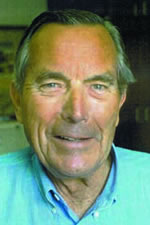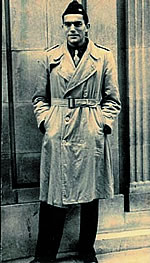|
|
Vol.
25 No. 5
September-October 2003
Role
Models in Chemistry - Nelson Leonard
This
new feature column, edited by Balazs Hargittai and István
Hargittai, will cover acclaimed persons in the international
chemistry community.
by
Balazs Hargittai and István Hargittai
 |
|
N.
Leonard
|
Nelson
J. Leonard is a world-renowned organic chemist acclaimed for
his skill in organic synthesis. His work has answered questions
of fundamental importance to biochemistry and life processes.
Leonard invented fluorescent probes and dimensional probes
of enzyme-coenzyme binding sites and DNA double-helical cross
sections. Leonard has been very active in IUPAC. He served
on the Editorial Advisory Board of IUPAC from 1984-1991
and he was President of the Organic Chemistry Division of
IUPAC from 1991-1993.
Leonard
(born in 1916 in Newark, New Jersey) is the Reynold C. Fuson
professor of chemistry emeritus of the University of Illinois,
Urbana-Champaign, and faculty associate at the California
Institute of Technology in Pasadena. He received his B.S.
degree from Lehigh University in 1937; a B.Sc. Degree from
the University of Oxford in 1940, following his Rhodes Scholarship
there; and his Ph.D. from Columbia University in 1942. Leonard
retired from the University of Illinois in 1986 after 44 years.
He served as scientific consultant and special investigator,
Field Intelligence Technical Agency, U.S. Army and U.S. Department
of Commerce, European Theater, during 1945-1946. He was
elected a member of the National Academy of Sciences of the
USA in 1955. Leonard's distinctions include the Roger Adams
Award in Organic Chemistry (1981) and the Arthur C. Cope Scholar
Award (1995).
 |
|
N.
Leonard at Höechst, Germany
in 1945 (courtesy of N. Leonard).
|
Leonard's
father was a salesman in New York and his mother was a housewife.
As a child, he had his own chemistry set and in high school
he had a good chemistry teacher. Following his career at Urbana-
Champaign, he started a second career at Cal Tech where he
first went as a Sherman Fairchild Distinguished Scholar in
the fall of 1991.
While
at Cal Tech he has written review articles based upon some
of his earlier discoveries, such as fluorescent derivations
of ATP and related compounds. According to Dr. Leonard, it
is a good though passive way to keep up with the field. One
of his projects, upon invitation from Tetrahedron, was
to write a "Perspectives" article about his career. He decided
to write about what was different about his scientific life.
He enjoyed collaboration with other scientists in other places
and in other disciplines, so he titled the piece "The 'Chemistry'
of Research Collaboration."
When
WWII broke out in Europe, Leonard was in Oxford and had to
return to the USA. Back in the states, he pursued a Ph.D.
at Columbia University, where he worked on alkaloid chemistry.
He soon determined that the fun part for him was synthetic
organic chemistry and working with natural products. After
receiving his Ph.D. in 1942, he headed to the University of
Illinois, where his research was concentrated on antimalarials.
As a confirmed New Yorker, he thought he would give the Midwest
a year and then return to New York. However, he found the
Illinois campus a fascinating place, with excellent people
at the time: Roger Adams, Carl S. ("Speed") Marvel, Harold
Snyder, and Charles C. Price III were his colleagues.
 |
| N.
Leonard making a stereochemical point, in 1968 (courtesy
of N. Leonard). |
When
the war ended, Dr. Leonard got a temporary job with the U.S.
Army overseas as part of an industrial intelligence unit (F.I.A.T.).
Stationed in Höechst, Germany, the unit was charged with
examining the research publications and research reports of
the I. G. Farbenindustrie. Before the war had ended, the intelligence
unit had started interviewing directors of research and others
from German industry. Eventually, the unit was instructed
to obtain details from research reports and manufacturing
procedures. They found a number of things that could be applied
in American industry. For example, the production of good
synthetic rubbers in the USA was aided by information about
a particular long-chain mercaptan that had been used in Germany
as a modifier in rubber manufacture.
However,
they did not see any reports from the infamous I. G. Farben
Auschwitz, the Buna and synthetic fuel works. This was not
surprising because, according to Joseph Borkin of the Antitrust
Division of the Department of Justice, writing in his book
The Crime and Punishment of I. G. Farben, most of its
records were destroyed so that the slave workers in concentration
camps could be obscured. When the Cold War started, the idea
of taking technical information from Germany ceased to be
popular. It was considered important that German industry
should be given an opportunity for revival. The decision was
political and military, but this change happened after Dr.
Leonard’s time in Germany.
Being
stationed in Germany allowed Leonard to be reunited with a
Dutch woman, Louise Vermey, to whom he had become engaged
just before he returned to the USA in 1939. His fiancée
spent all of the war years in the Netherlands. They met again
in 1945 and married in 1947. In 1987, Louise died of cancer.
In 1992, Leonard married Peggy Phelps.
Dr.
Leonard's research interests kept shifting during his career.
In the first decade, he and his students worked on reductive
cyclizations, electrolytic reductions, molecular rearrangements,
and the stereochemistry of 1,2-dicarbonyl compounds. After
his first sabbatical leave, he worked on medium-ring compounds,
discovering some transannular interactions and reactions,
and on small charged rings, discovering some ringenlargement
reactions of aziridinium and azetidinium salts.
During
a sabbatical leave in Switzerland in 1960, he started reading
biochemistry, but the initiative for research came from one
of his students back home, Jim Deyrup, who was working on
a natural product, triacanthine, that turned out to have a
3-substituted adenine structure, 3-(Æ2-isopentenyl) adenine.
Most of the adenines known up to that time were substituted
at the 9-position. The 3-substitution was a nice surprise
and served as a channel into biochemistry through 3-isoadenosine
and its mono-, di-, tri-, and cyclic phosphates. For example,
3-iso-ATP turned out to have many coenzyme activities similar
to those of natural ATP, adenosine triphosphate.
An
isomer of triacanthine, namely N6-isopentenyladenine,
because of its cytokinin activity (plant-cell growth, division,
and differentiation) was a channel into plant physiology.
Leonard started collaboration with Folke Skoog, professor
of Plant Physiology at the University of Wisconsin. They worked
together for 20 years and published more than 40 papers together.
Another
scientist with whom he had a fruitful collaboration was Professor
Gregorio Weber (1916-1997), a great man in fluorescence.
Weber went to the University of Illinois from Argentina by
way of England, and he excited everybody about fluorescence.
In the early 1970s, Leonard's group made fluorescent derivatives
of the nucleic acid bases so that they could be detected and
would indicate, by fluorescence lifetime, yield, and polarization,
and how they were attached to an enzyme or structural protein.
The fluorescent derivative of ATP, namely 1,N6- etheno-ATP,
became the most popular in numerous applications thereafter.
Leonard
and his group continued with many different research projects
based upon fluorescence. They constructed a compound that
was a fluorescent dimensional probe of ATP (i.e., linear-benzo-ATP,
with the same terminal rings as in ATP but with a central
benzene ring built in, thus making it 2.4 angstroms wider
than the natural coenzyme). One of Leonard's final projects,
conducted with Dr. Balkrishen Bhat, involved a fluorescent,
covalently linked cross section of DNA consisting of five
fused rings and having the same or very similar geometry to
a hydrogen-bonded pair of DNA bases. It just wouldn't come
apart. The final goal, which is still unobtained, was to incorporate
the covalent cross section to see, in a replicating cell system,
whether there was something inserted that prevents the two
DNA strands from coming apart, thus inhibiting replication,
especially as in fast-growing cancer cells.
Leonard
has directed over 120 Ph.D. students and 91 post doctorates
and published over 400 papers. His legacy is honored by the
annual Nelson J. Leonard Lectureship at the University of
Illinois, which is sponsored by his students and former colleagues.
Before joining Cal Tech in 1992, Leonard held visiting appointments
at the National Institutes of Health in Bethesda, Maryland,
and at the University of California, San Diego.
Leonard's
heroes include Roger Adams, who was still fully active when
he got to Illinois, although he was tied up with the war.
In turn, he was to become General Clay's science advisor in
Germany and General MacArthur's science advisor in Japan.
At Oxford, Leonard appreciated Robert Robinson and at Columbia,
Harold Urey was his hero.
Dr.
Balazs Hargittai is assistant professor at St. Francis University
in Loretto, Pennsylvania; his research interest is in peptide
chemistry. Dr. István Hargittai is at Budapest University
of Technology and Economics; <www.roadtostockholm.com>
Page
last modified 3 September 2003.
Copyright © 2002-2003 International Union of Pure and
Applied Chemistry.
Questions regarding the website, please contact [email protected]
|